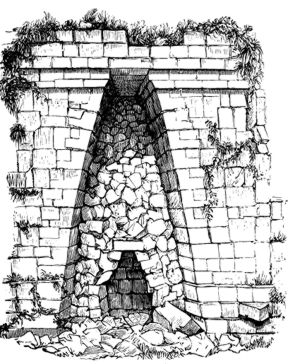THE KOSSUTH GIANTS

Sketch of the Tomb of the Kossuth Giants from the Dept. of Archaeology, Georg von Podebrad College
Now very curious as to the nature of the find, he called several friends from surrounding farms and they began an excavation. They discovered that it was not a single stone, but rather one of at least several irregularly cut slabs stretching out over a wide area, yet fitted so tightly together that not even a knife blade could be put between them. Each slab measured roughly 8'x10', and when struck with a sledge seemed to ring with a hollowness that might indicate this was not a floor but the outside portion of a ceiling. Rainwater wondered if he had not stumbled upon some sort of buried stone structure on his property. Believing that there might be a way to parlay living other than farming if he played his cards right, Mr. Rainwater contacted Georg Von Podebrad College, who in turn dispatched a team of archeologists, anthropologists, and geologists to the site.
The researchers were delighted with the anomalies presented them. Firstly, the stone was not at all native to Iowa, but was in fact basalt-a hard, dense volcanic rock composed of plagioclase, augite, and magnetite. The type of stone used by the Egyptians to build their massive monuments. The depth of the slabs indicated that they had been there for a very long time, predating the advent of the kind of modern transportation and heavy machinery needed to bring such a large quantity of foreign stone to Iowa, and quite probably the slabs had been laid down before the last glacial age. It is impossible to gauge with any certainty just how long they had been there.
After the soil covering the slabs had been entirely removed, the area covered by the stones was a perfect square measuring 188 feet on each side. Digging around the perimeter revealed that Rainwater had been correct, the structure did go deeper into the ground. The cyclopean structure was revealed to be a pyramid similar in shape to one located at Marietta, Ohio, although those mounds and monuments erected by the prehistoric Indians were made of sun dried brick mixed with rushes. This technique, too, is curiously similar to the Egyptian technique of brick making with straw and mud.

Mummified remains of a giant.
Photo courtesy of
Dept. of Archaeology, GvP College
After careful excavation of the site, the bodies were removed for x-ray and autopsy examination. The eximent over the find was far in excess of the "Gypsum Man" find in Iowa so many years before-a hoax from which the Putnam Museum of Davenport had never fully recovered from. These giants were very real. The medical examinations demonstrated that there was definite skeletal structure, that they were organic creatures who had once been very much alive.
One explanation for the mummies might lie in the legends of the Paiute Indians who tell of a race of red-haired giants who were their mortal enemies centuries ago. They were called the Si-Te-Cahs, driven from Nevada by a previously unheard of alliance of tribes. Did the Si-Te-Cahs retreat from the west to Iowa? Was the stone structure here before and simply co-opted by the giants? No one may ever know, however it is interesting to note that among the Indian relics held in the Kossuth County chapter of the State Historical Society are three robes made entirely from very long strands of red hair. We await DNA comparisons of samples taken from the mummies and the robes to determine a connection.
In the mean-time, Marvin Rainwater has had his farm purchased by interested parties in Hopkins Grove for an undisclosed sum, and is quite happily no longer toiling in his fields or digging wells.
Back to this Issue Contents
